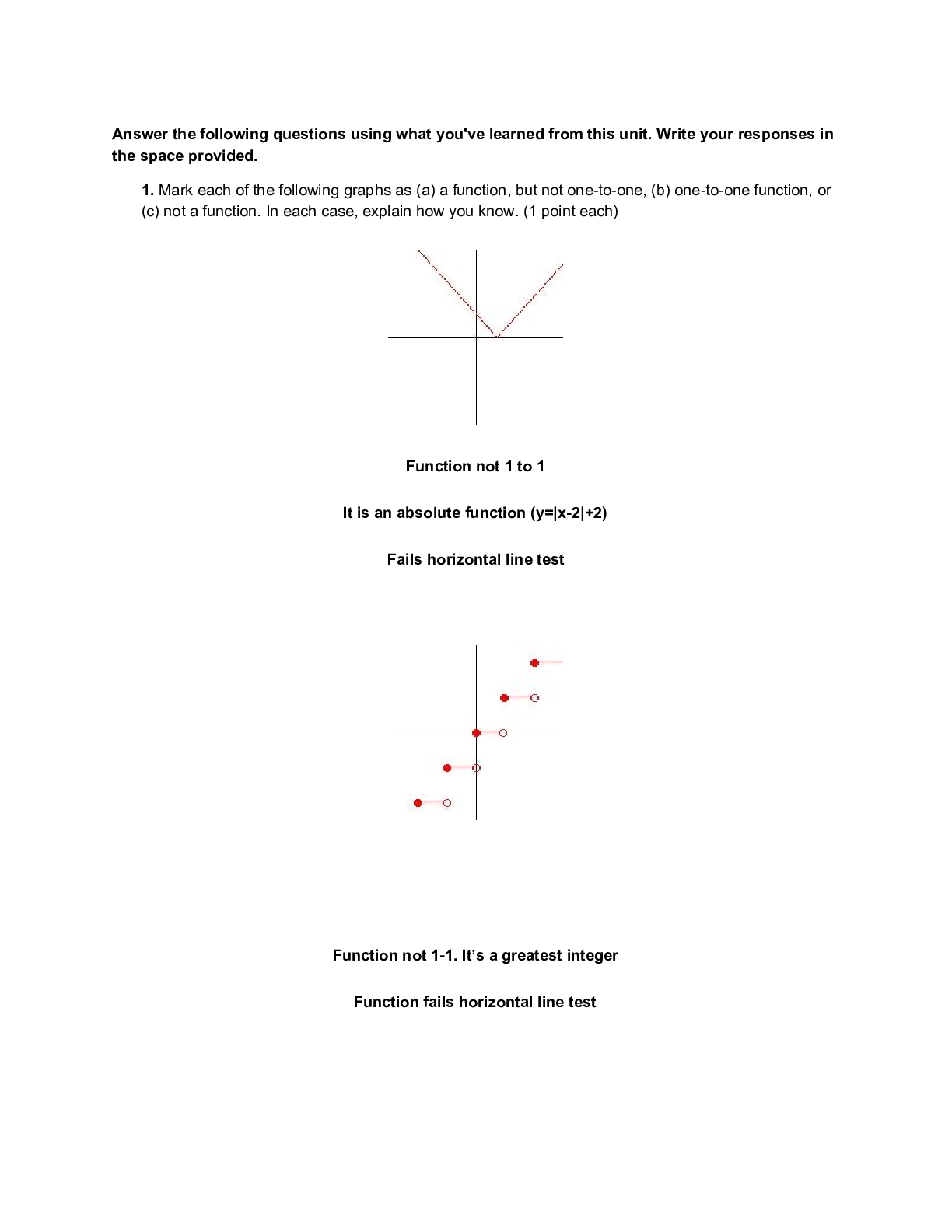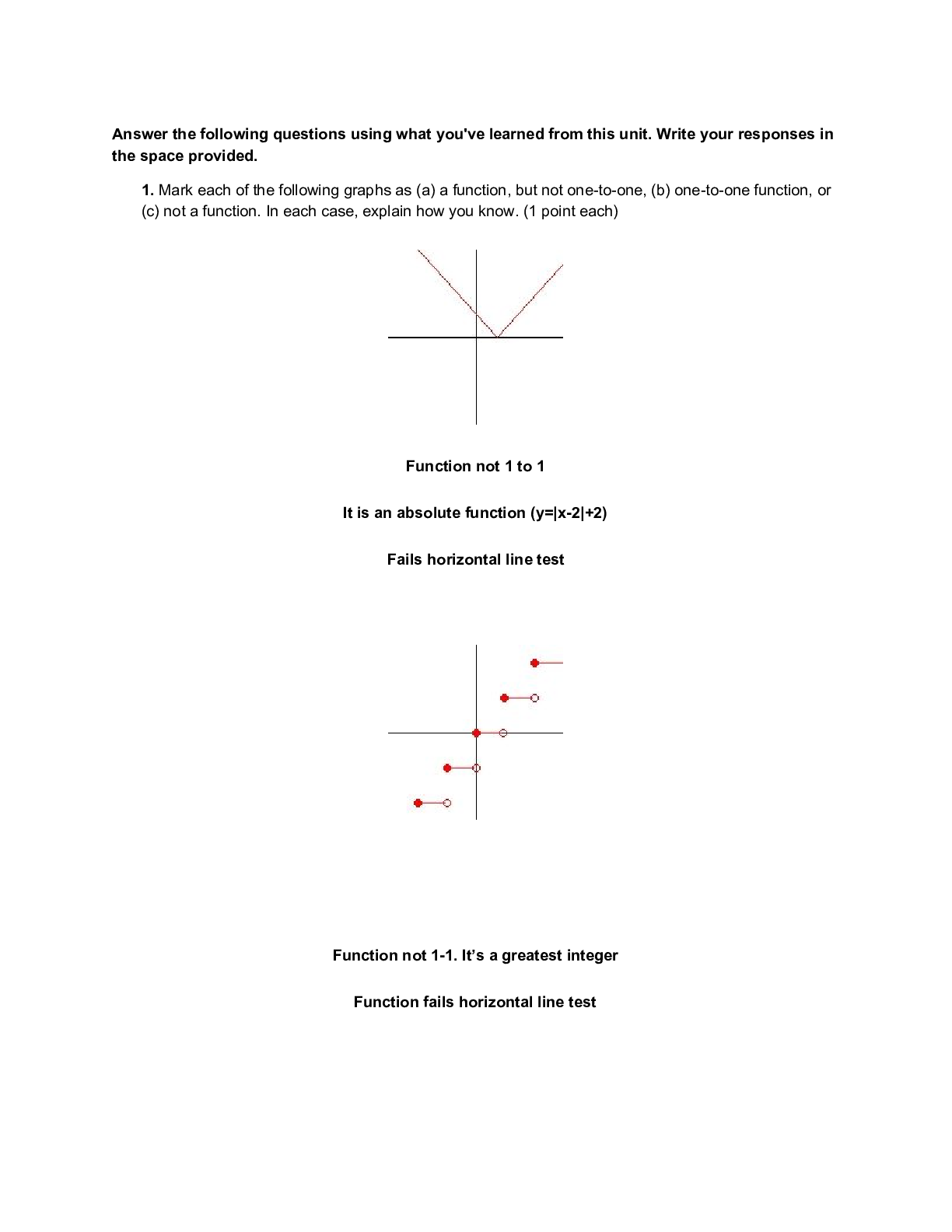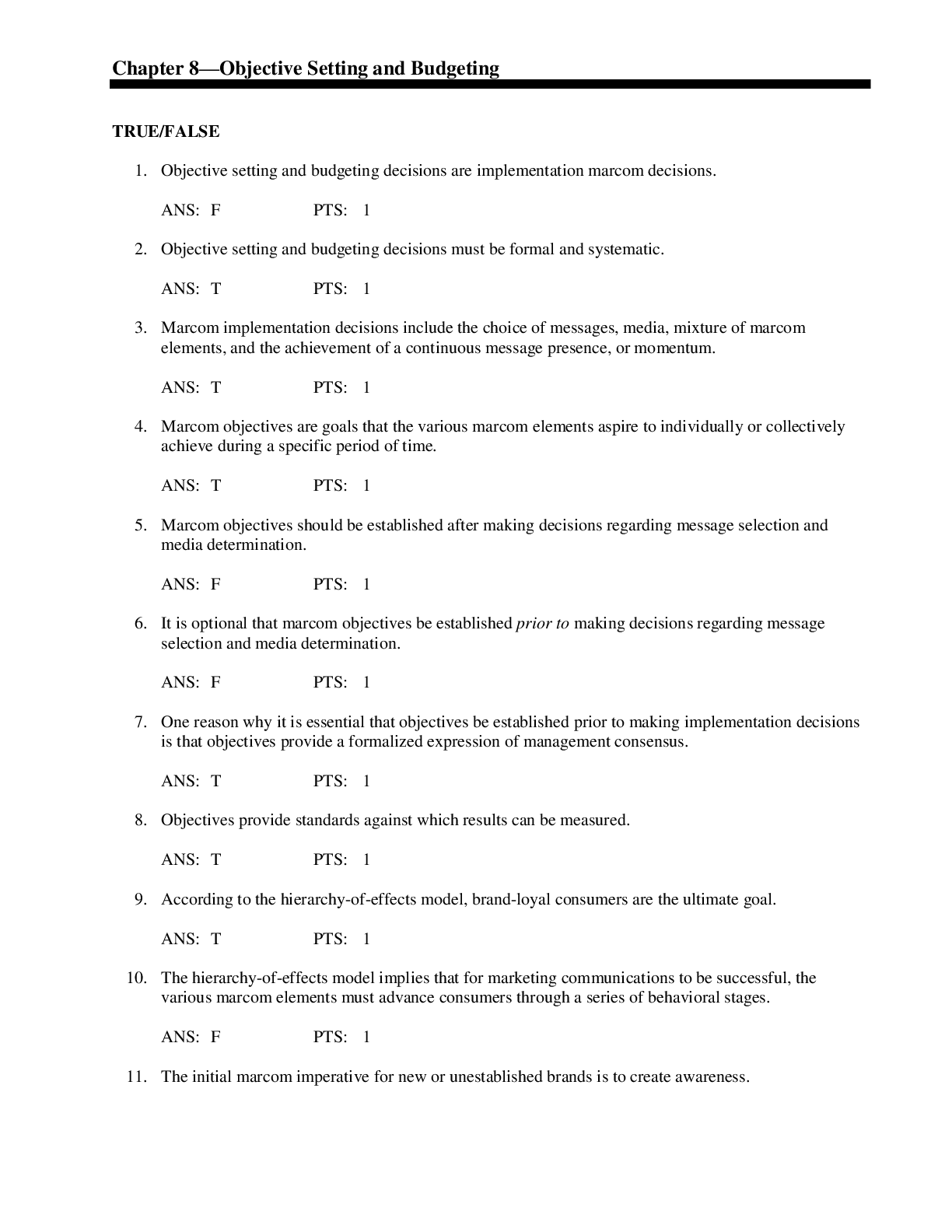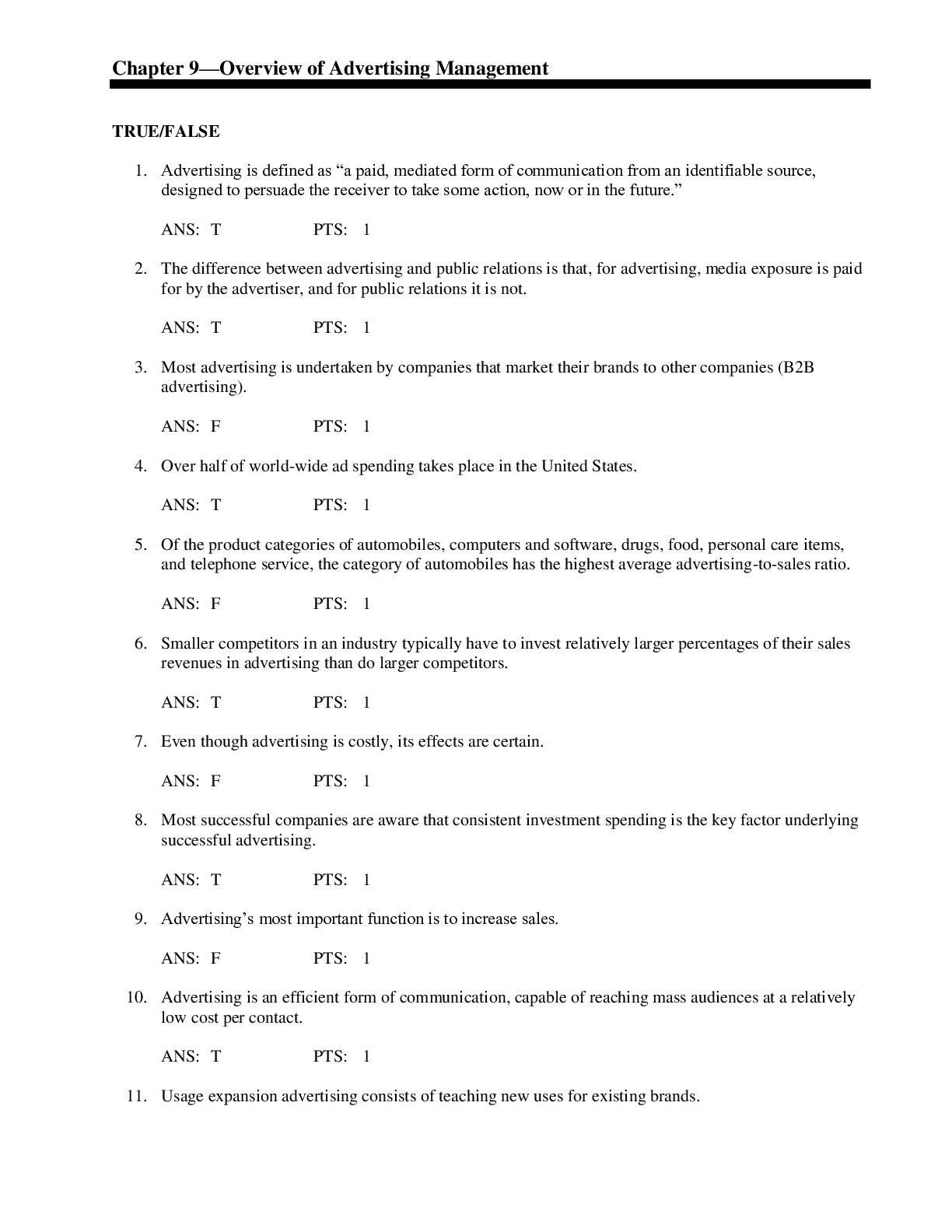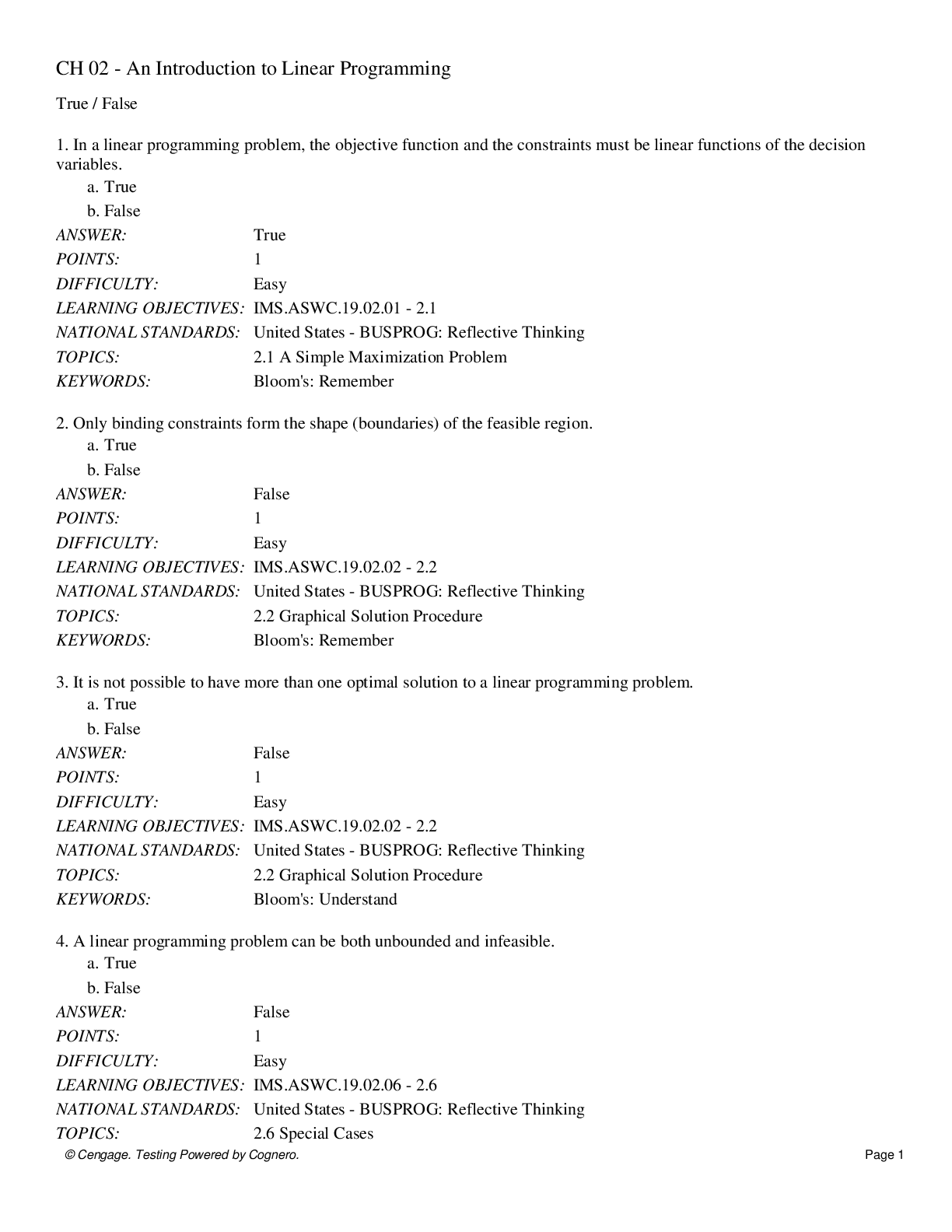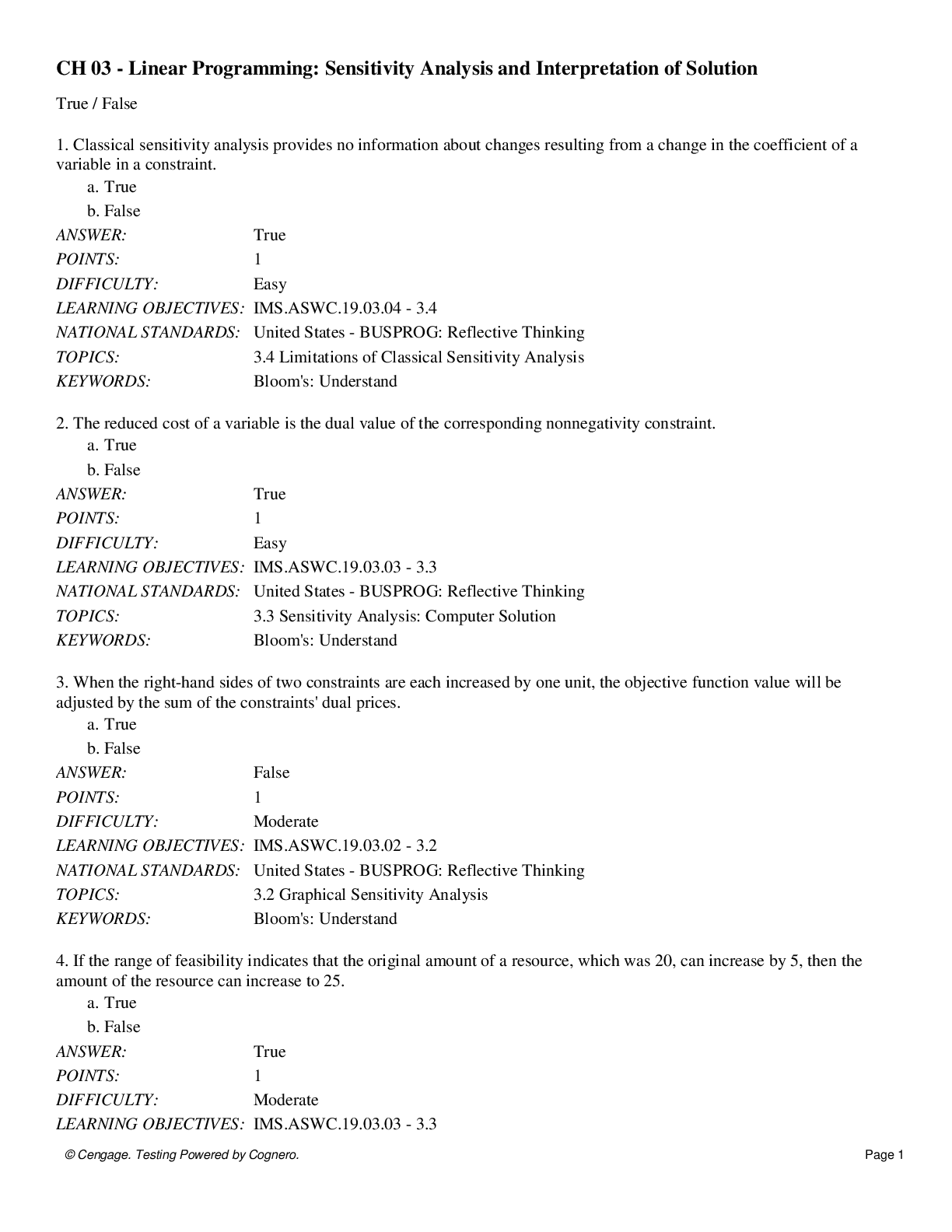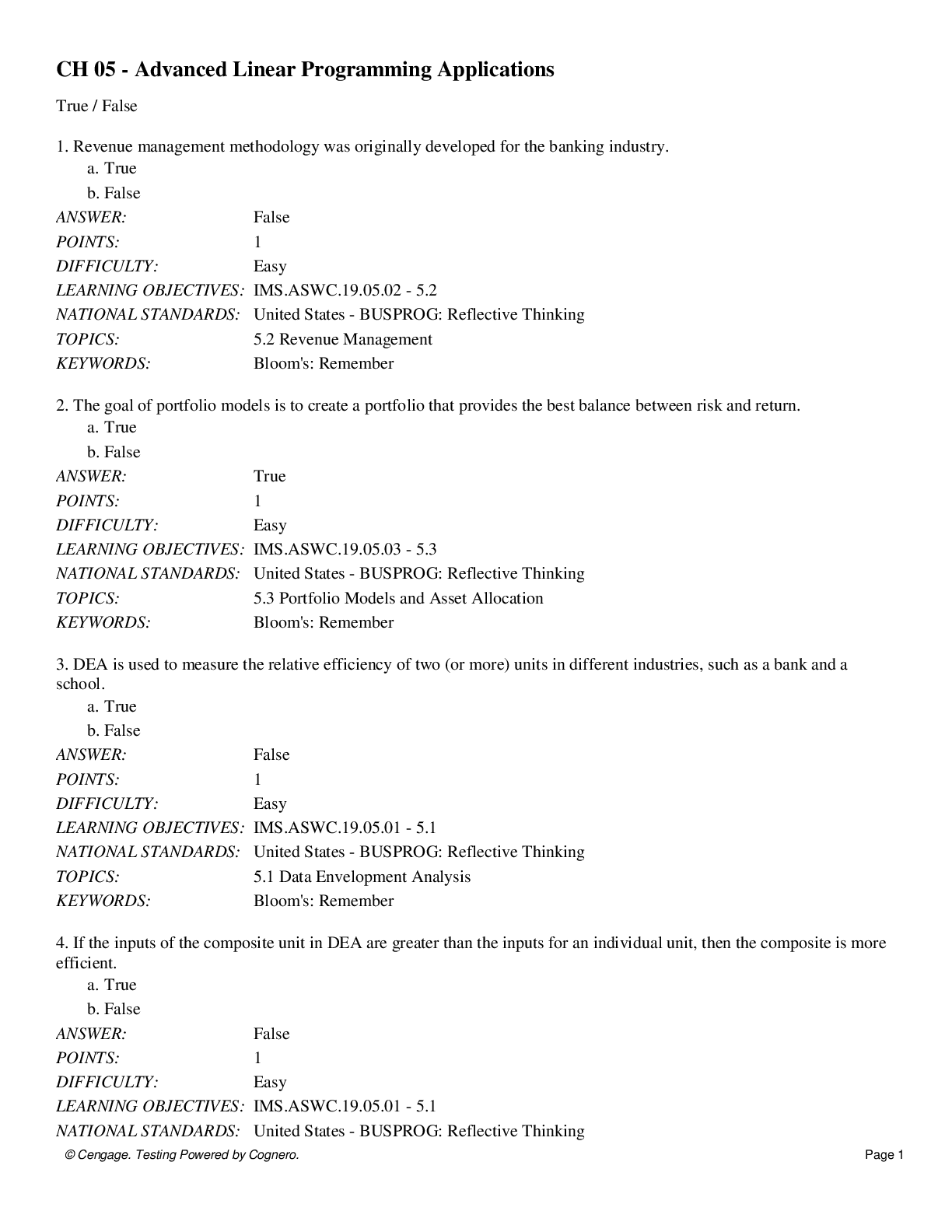*NURSING > QUESTIONS & ANSWERS > NURSING: PHARMACOLOGICAL Questions and Answers with Explanation: Exam Practice and Review (All)
NURSING: PHARMACOLOGICAL Questions and Answers with Explanation: Exam Practice and Review
Document Content and Description Below
NURSING: PHARMACOLOGICAL Questions and Answers with Explanation: Exam Practice and Review Question 1 When positioned properly, the tip of a central venous catheter should lie in the: Question ... 2 While the nurse is caring for a neonate at 32 weeks' gestation in an isolette with continuous oxygen administration, the neonate's mother asks why the neonate's oxygen is humidified. The nurse should tell the mother? Question 3 A client receives an IV dose of gentamicin sulfate. How long after the completion of the dose should the peak serum concentration level be measured? Question 4 On the second day following an abdominal hysterectomy, a client reports she has had three brown, loose stools in moderate amount. The morning medications include an order for 100 mg of docusate sodium daily or as needed. What should the nurse do next? Question 5 In teaching a client with tuberculosis about self-care at home, which directive has the highest priority? Question 6 When starting the client’s intravenous infusion line, the nurse applies a tourniquet and selects the site for inserting the needle. When should the nurse remove the tourniquet? Question 7 The nurse has an order to administer 2 oz of lactulose to a client who has cirrhosis. How many milliliters of lactulose should the nurse administer? Record your answer using a whole number. Question 8 A client taking disulfiram during alcohol rehabilitation therapy reports to the nurse that he has a mild cold and plans to use a cough medicine. Which statement made by the client indicates understanding of the nurse's teaching? Question 9 A client with a history of Addison’s disease is experiencing weakness and headache. The vital signs are blood pressure of 100/60 and heart rate of 80. Laboratory values are Na 130, potassium 4.8, and blood glucose 70. Which of the following would the nurse expect to administer? Question 10 A nurse is caring for a client receiving morphine, 4 mg I.V. every hour, as needed to relieve pain. What teaching should the nurse provide? Question 1 A child is being discharged with albuterol nebulizer treatments. The nurse should instruct the parents to watch for: Question 2 A nurse preceptor is working with a student nurse who is administering medications. Which statement by the student indicates an understanding of the action of an antacid? Question 3 A client must take streptomycin for tuberculosis. Before therapy begins, the nurse should instruct the client to notify the physician if which health concern occurs? Question 4 The nurse should advise which client who is taking lithium to consult with the health care provider (HCP) regarding a potential adjustment in lithium dosage? Question 5 The antidote for heparin is: Question 6 The nurse should plan to teach a client who is taking warfarin sodium to: Question 7 The nurse administers an intradermal injection to a client. Proper technique has been used if the injection site demonstrates: Question 8 What finding should the nurse interpret as indicating that a child is receiving too much IV fluid too rapidly? Question 9 A client with heart failure will take oral furosemide at home. To help the client evaluate the effectiveness of furosemide therapy, the nurse should teach the client to: Question 10 The client with rheumatoid arthritis has been taking large doses of aspirin to relieve joint pain. The nurse should assess the client for: Question 11 A client with chest pain doesn't respond to nitroglycerin. When he's admitted to the emergency department, the health care team obtains an electrocardiogram and administers I.V. morphine. The physician also considers administering alteplase. This thrombolytic agent must be administered how soon after onset of myocardial infarction (MI) symptoms? Question 12 While obtaining a health history, a nurse learns that a client is allergic to bee stings. When obtaining this client's medication history, the nurse should determine if the client keeps which medication on hand? Question 13 A nurse is teaching a client with type 1 diabetes how to treat adverse reactions to insulin. To reverse hypoglycemia, the client ideally should ingest an oral carbohydrate. However, this treatment isn't always possible or safe. Therefore, the nurse should advise the client to keep which alternate treatment on hand? Question 14 A client is receiving an I.V. infusion of mannitol after undergoing intracranial surgery to remove a brain tumor. To determine whether this drug is producing its therapeutic effect, the nurse should consider which finding most significant? Question 15 Which statement indicates that the client needs further teaching about taking medication to control cancer pain? Question 16 An elderly male client has been taking doxazosin 2 mg daily for 4 weeks for treatment of benign prostatic hypertrophy. The client reports feeling dizzy. The nurse should first: Explanation: Doxazosin is also used as an antihypertensive agent; the client may be experiencing orthostatic hypotension. The nurse should first take the client’s blood pressure; later, the nurse can review other medications. Question 17 A client states, “I have never taken a yellow pill before for my blood pressure. Why are you giving me this pill?” After verifying that the nurse has prepared the correct medication, which of the following would be an accurate statement by the nurse? Question 18 A client prescribed propranolol calls the clinic to report a weight gain of 3 lbs (1.36 kg) within 2 days, shortness of breath, and swollen ankles. What is the nurse’s best action? Question 19 Two days after a client undergoes repair of a ruptured cerebral aneurysm, a physician orders mannitol, 0.5 g/kg to be infused over 60 minutes. The client weighs 175 lb. The nurse should administer how many grams of mannitol? Record your answer using a whole number. Question 20 Eardrops have been prescribed to be instilled in the adult client’s left ear to soften cerumen. To position the client, what should the nurse do? TAKE A PRACTICE QUIZ Question 1 To treat a child's atopic dermatitis, a physician orders a topical application of hydrocortisone cream twice daily. After medication instruction by the nurse, which statement by the parent indicates effective teaching? Question 2 A nurse has just administered a drug to a child. Which organ is most responsible for drug excretion in children? Question 3 A client is admitted to the local psychiatric facility with bipolar disorder in the manic phase. The physician decides to start the client on lithium carbonate therapy. One week after this therapy starts, the nurse notes that the client's serum lithium level is 1 mEq/L. What should the nurse do? Question 4 A physician orders morphine for a client who complains of postoperative abdominal pain. For maximum pain relief, when should the nurse anticipate administering morphine? Question 5 A client with obsessive-compulsive disorder, who was admitted early yesterday morning, must make his bed 22 times before he can have breakfast. Because of his behavior, the client missed having breakfast yesterday with the other clients. Which action should the nurse institute to help the client be on time for breakfast? Question 6 The nurse is working on discharge plans with a client who is diagnosed with intermittent explosive disorder, characterized by sudden angry outbursts. The nurse determines that the client is ready for discharge when he makes which comment? Question 7 The nurse instructs a client who is taking iron supplements that: Question 8 An IV infusion is to be administered through a scalp vein on an infant's head. What should the nurse tell the parents to prepare them for the procedure? Question 9 A client with human immunodeficiency virus (HIV) infection is taking zidovudine (AZT). The expected outcome of AZTis to: Question 10 After undergoing small-bowel resection, a client is prescribed metronidazole 500 mg intravenously. The mixed solution is 100 ml. The nurse is to administer the drug over 30 minutes. The drop factor of the available intravenous tubing is 15 gtt/ml. What is the drip rate in drops per minute? Record your answer using a whole number. (For example: 62) Question 11 A 30-year-old multiparous client has been prescribed oral contraceptives as a method of birth control. The nurse instructs the client that decreased effectiveness may occur if the client is prescribed which drug? Question 12 The nurse is preparing to administer 0.1 mg of digoxin intravenously. Digoxin comes in a concentration of 0.5 mg/2 ml. How many milliliters should the nurse administer? Record your answer using one decimal place. Question 13 A client is brought to the emergency department unconscious. An empty bottle of aspirin was found in the car, and a drug overdose is suspected. Which medication should the nurse have available for further emergency treatment? Question 14 A nurse receives a lithium level report of l.0 mEq/L (1 mmol/L) for a client who has been taking lithium for 2 months. How does the nurse interpret this information? Question 15 The physician prescribes acetaminophen 650 mg by mouth every 4 hours for a client with a temperature of 102° F (38.8° C) who has a feeding tube in place. The nurse has acetaminophen solution on hand containing 160 mg/5 ml. How many milliliters of solution should the nurse administer? Record your answer using one decimal place. Question 16 A 10-year-old client with asthma is prescribed 2 mg of albuterol syrup four times per day. The syrup comes in a dosage strength of 2 mg/5 mL. How many milliliters of syrup should the nurse administer? Record your answer using a whole number. Question 17 The nurse is justified in assessing for sexual dysfunction among male clients who are taking: Question 18 The nurse is caring for a client who is receiving parenteral nutrition. Which of the following assessments is most important for the nurse to make in order to detect early signs of metabolic complications? Question 19 Which statement indicates that a client understands the nurse’s teaching about phenytoin for the diagnosis of seizures? Question 20 The nurse is caring for an infant diagnosed with thrush. Which instruction would the nurse give to a client’s mother who will be administering nystatin oral solution? When positioned properly, the tip of a central venous catheter should lie in the: Question 2 The administration of medications during infancy is often necessary. The nurse needs to be concerned about the metabolism of these drugs. What concern regarding metabolism should the nurse consider when administering medications to an infant? Question 3 A client at 28 weeks' gestation is complaining of contractions. Following admission and hydration, the physician writes an order for the nurse to give 12 mg of betamethasone I.M. This medication is given to: Question 4 A nurse is teaching a client about hormonal contraceptive therapy. If a client misses three or more pills in a row, the nurse should instruct the client to: Question 5 A client with rheumatoid arthritis has been on aspirin therapy for an extended time. Which assessment is the most important for the nurse to obtain? Question 6 A client with lung cancer has developed an intractable, nonproductive cough that is unrelieved by nonopioid antitussive agents. The physician orders codeine, 10 mg P.O. every 4 hours. Which statement accurately describes codeine? Question 7 The health care provider (HCP) has prescribed nitroglycerin to a client with angina. The client also has closed-angle glaucoma. The nurse contacts the HCP to discuss the potential for: Question 8 A school-age child diagnosed with attention deficit hyperactivity disorder is prescribed methylphenidate. What finding should alert the school nurse to the possibility that the child is experiencing a common side effect of the drug? Question 9 A 36-month-old child weighing 20 kg (44 lb) is to receive ceftriaxone 2 g IV every 12 hours. The recommended dose of ceftriaxone is 50 to 75 mg/kg/day in divided doses. The nurse should: Which body system is not blocked by spinal anesthesia? Question 11 A client had a total abdominal hysterectomy and bilateral oophorectomy for ovarian carcinoma yesterday. She received 2 mg of morphine sulfate I.V. by patient-controlled analgesia (PCA) 10 minutes ago. The nurse was assisting her from the bed to a chair when the client felt dizzy and fell into the chair. The nurse should: Question 12 A client with acute asthma is prescribed short-term corticosteroid therapy. Which is the expected outcome for the use of steroids in clients with asthma? Question 13 A primigravid client in active labor has just received an epidural block for pain. After administration of the epidural block, the nurse should assess the client for: Question 14 A client has received an overdose of sympathomimetic agents. The nurse should assess the client for which late signs of an overdose? Select all that apply. Question 15 An older client with diabetes who has been maintained on metformin has been scheduled for a cardiac catheterization. The nurse should verify that the health care provider (HCP) has written a prescription to: Question 16 The client with type 1 diabetes mellitus is taught to take isophane insulin suspension NPH at 1700 each day. The client should be instructed that the greatest risk of hypoglycemia will occur at about what time? Question 17 Two weeks before a client is scheduled for an ileostomy, the nurse should instruct the client to: Question 18 A nurse is providing health teaching about pediatric immunizations to the parents of a child. Which of the following is the most appropriate information for the nurse to give the parents about immunizations? Question 19 A 65-year-old client, who is experiencing a stroke, has been ordered alteplase. The order is for 0.9 mg/kg over one hour. The client weighs 110 lb (50 kg). What is the total dose in milligrams Question 20 Which nifedipine-related side effect should the nurse be most concerned with when caring for a new stroke admission? Question 1 A drug must enter the bloodstream before it can act within the body. Which parenteral administration route places a drug directly into the circulation, requiring no absorption? Question 2 A physician orders codeine, ½ grain every 4 hours, for a client experiencing pain. How many milligrams of codeine should the nurse administer? Question 3 What is the main advantage of using a floor stock system? Question 4 Assessment of a client taking a nonsteroidal anti-inflammatory drug (NSAID) for pain management should include specific questions regarding which body system? Question 5 A neonate weighing 1,870 g with a respiratory rate of 46 breaths/minute, a pulse rate of 175 bpm, and a serum pH of 7.11 has received sodium bicarbonate intravenously. The drug has been effective if the neonate: TAKE A PRACTICE QUIZ Question 1 A nurse notes that a client's I.V. insertion site is red, swollen, and warm to the touch. Which action should the nurse take first? Remediation: Question 2 A client with alcohol dependency is started on a regimen of disulfiram. Which statement should the nurse include when teaching the client about the intended effects of the drug? Question 3 A woman who is Rh-negative has given birth to an Rh-positive infant. The nurse explains to the client that she will receive Rho(D) immune globulin (RhoGAM). The nurse determines that the client understands the purpose of RhoGAM when she states: Question 4 The nurse has an order to administer 2 oz of lactulose to a client who has cirrhosis. How many milliliters of lactulose should the nurse administer? Record your answer using a whole number. Question 1 The administration of medications during infancy is often necessary. The nurse needs to be concerned about the metabolism of these drugs. What concern regarding metabolism should the nurse consider when administering medications to an infant? Question 2 A 28-year-old female client is prescribed danazol for endometriosis. The nurse should instruct the client to report: Question 3 The primary care provider prescribes an intravenous infusion of oxytocin to induce labor in a 22-year-old primigravida client with insulin-dependent diabetes at 39 weeks’ gestation. The fetus is in a cephalic position, and the client’s cervix is dilated 1 cm. What should the nurse do before starting the oxytocin induction? Question 1 The administration of medications during infancy is often necessary. The nurse needs to be concerned about the metabolism of these drugs. What concern regarding metabolism should the nurse consider when administering medications to an infant? . Remediation: Question 2 A 28-year-old female client is prescribed danazol for endometriosis. The nurse should instruct the client to report: Question 3 The primary care provider prescribes an intravenous infusion of oxytocin to induce labor in a 22-year-old primigravida client with insulin-dependent diabetes at 39 weeks’ gestation. The fetus is in a cephalic position, and the client’s cervix is dilated 1 cm. What should the nurse do before starting the oxytocin induction? Question 4 Which adverse effects occur when there is too rapid an infusion of TPN solution? Question 5 A nurse evaluating a school-age child for signs and symptoms of adverse effects from morphine should assess for which of the following? Select all that apply. Remediation: Question 1 Which instruction is most important for the nurse to include in the teaching plan for a client who is taking phenelzine? Question 2 After teaching a client how to instill nose drops, the nurse evaluates that the client’s technique is correct when the client: Question 3 A nurse explains to a client that she will administer his first insulin dose in his abdomen. How does absorption at the abdominal site compare with absorption at other sites? Question 4 A client is admitted to an acute care facility after an episode of status epilepticus. After the client is stabilized, which factor is most beneficial in determining the potential cause of the episode? Question 5 A client is receiving lithium carbonate for a bipolar disorder. The nurse is aware that early signs of lithium toxicity include which of the following? Question 1 When assessing a client's I.V. insertion site, a nurse notes normal color and temperature at the site and no swelling. However, the I.V. solutions haven't infused at the ordered rate; the flow rate is slow even with the roller clamp wide open. When the nurse lowers the I.V. fluid bag, no blood returns to the tubing. What should the nurse do first? Remediation: Question 2 A 16-year-old adolescent sustains a severe head injury in a motor vehicle accident. He's admitted to the neurologic unit and subsequently develops neurogenic diabetes insipidus. The physician orders vasopressin, 5 units subcutaneously (subQ) twice per day. How long will the effects of the vasopressin last? Question 3 A client with type 1 diabetes takes 15 units of insulin isophane before breakfast and 8 units before dinner. During a follow-up visit, the nurse reevaluates the client's knowledge about insulin therapy and self-administration skills. The nurse realizes the client requires additional teaching when she discovers the client takes which over-the-counter preparations? The client requires additional teaching if he takes salicylates with insulin. Salicylates may interact with insulin, causing hypoglycemia. Antacids, vitamins with iron, and acetaminophen aren't known to interact with insulin. Remediation: Question 4 Atropine sulfate is included in the preoperative prescriptions for a client undergoing a modified radical mastectomy. The expected outcome is to: Question 5 The nurse is caring for a 12-kg child diagnosed with epiglottitis. Vancomycin 50mg/kg/day in three divided doses is prescribed. The medication is supplied as 500 mg/100 ml. How many milliliters per dose will the nurse administer? Record your answer using a whole number. Question 1 A nurse is assessing a child who recently received an antibiotic for an ear infection. The mother states that her child seems to have a harder time hearing than before and that the child told her that he hears ringing in his ears. The nurse suspects the child is taking an antibiotic from which class? Remediation: Question 2 A client takes isosorbide dinitrate as an antianginal medication. Which statement indicates that the client understands the adverse effects of the drug? Question 3 The nurse should instruct a woman taking folic acid supplements for folic acid-deficiency anemia that: Question 4 A school-age child with cystic fibrosis (CF) is suddenly losing weight, despite having a voracious appetite. The child has large, foul-smelling stools, with excessive gas, distention, and bloating. Which of the following is the nurse’s best assessment of the etiology of this problem? Question 5 A client with new-onset seizures of unknown cause is started on phenytoin. The health care provider has ordered a loading dose of 15 mg/kg IV to be given at a rate of 40 mg/min. What is the loading dose in milligrams if the client weighs 176 lb (80 kg)? Record your answer using a whole number. Question 2 A client is diagnosed with diabetes mellitus. The physician orders 15 units of U-100 regular insulin and 35 units of U-100 isophane insulin suspension (NPH) to be taken before breakfast. The nurse checks the medication order, assembles equipment, washes her hands, rotates the NPH insulin vial, puts on disposable gloves, and cleans the stoppers. To draw the two insulin doses into the single U-100 insulin syringe, which sequence should the nurse use? Question 5 A client with an intravenous line in place states having pain at the insertion site. Assessment of the site reveals a vein that is red, warm, and hard. Which actions would the nurse take? Select all that apply. Question 1 A physician orders heparin, 7,500 units, to be administered subcutaneously every 12 hours. The vial reads 10,000 units per milliliter. The nurse should anticipate giving how much heparin for each dose? Question 2 A nurse is developing a teaching plan for a client who has just been diagnosed with breast cancer. The nurse should include information about: Question 3 The administration of medications during infancy is often necessary. The nurse needs to be concerned about the metabolism of these drugs. What concern regarding metabolism should the nurse consider when administering medications to an infant? Question 4 A nurse is assigned to a client who, after a medication teaching session with her, began receiving amitriptyline hydrochloride to treat depression. One week after starting this drug, the client refuses to take the medication. He says it has caused blurred vision, dry mouth, and constipation, but it hasn't improved his mood. Which nursing diagnosis is appropriate for this client? Question 5 A physician orders a single dose of trimethoprim/sulfamethoxazole by mouth for a client diagnosed with an uncomplicated urinary tract infection. The pharmacy sends three unit-dose tablets. The nurse verifies the physician's order. What should the nurse do next? Question 6 A client is taking vancomycin. The nurse should report which possible side effect to the health care provider (HCP)? Question 7 What should be the nurse’s priority assessment after an epidural anesthetic has been given to a nulligravid client in active labor? Question 8 The nurse is preparing to administer propranolol to a client for control of migraine headaches. The client also has a prescription for sumatriptan as needed for a headache. The client’s pulse rate is 56 bpm. What should the nurse do next? Question 9 Atropine sulfate is included in the preoperative prescriptions for a client undergoing a modified radical mastectomy. The expected outcome is to: Question 10 A client with deep vein thrombosis has an I.V. infusion of heparin infusing at 1,500 units/hour. The concentration in the bag is 25,000 units/500 ml. How many milliliters of solution should the nurse document as intake from this infusion for an 8-hour shift? Record your answer using a whole number. Question 11 A nurse is assessing a client who is receiving clozapine. The nurse reviews the medical record. What should the nurse do next? Question 12 A physician orders triamcinolone and salmeterol for a client with a history of asthma. What action should the nurse take when administering these drugs? Question 13 A client diagnosed with schizophrenia is brought to the hospital from a group home where he became agitated, threw a chair at another client, and has been refusing medication for 8 weeks. The client exhibits a flat affect, is not caring for his hygiene, and has become increasingly withdrawn and asocial. The health care provider (HCP) prescribes treatment with risperidone to improve the client’s negative and positive symptoms of schizophrenia. When evaluating the drug’s effectiveness on the client’s negative symptoms, the nurse should expect improvement in which symptom? Question 14 The nurse is instructing the client on insulin administration. The client is performing a return demonstration for preparing the insulin. The client’s morning dose of insulin is 10 units of regular and 22 units of NPH. The nurse checks the dose accuracy with the client. The nurse determines that the client has prepared the correct dose when the syringe reads how many units? Record your answer using a whole number. Question 15 The physician has ordered an IV of 3000 mL of 0.9% sodium chloride to be infused over the next 24 hours. The nurse uses IV tubing that has a drip factor of 10. Calculate the drops per minute needed to deliver the correct amount of IV fluid. Record your answer using a whole number. Question 16 A client receiving digoxin has a serum magnesium level of 0.9 mg/dL (0.57 mmol/L). What is the nurse’s best action? Question 17 A client undergoing cancer chemotherapy has been prescribed epoetin alfa. The client is to receive 150 units/kg subcutaneously three times per week. The client weighs 90 kg. How many units will the nurse administer at each dose? Record your answer using a whole number. Question 18 A client in the intensive care unit (ICU) is on a dobutamine drip. During an assessment the client states, “I was feeling better but now my chest is tight and I feel like my heart is skipping.” Physical assessment reveals a heart rate of 110 beats per minute and blood pressure of 160/98 mm Hg. What is the nurse’s immediate concern for this client? Question 19 A client who had a total hip placement at 0900 is receiving an autologous blood transfusion that was started at 1100. At the change of shift (1500), the nurse working on the day shift reports that there is 50 mL of the unit of blood remaining to be infused. Which is a priority action for the nurse working on the evening shift? Question 20 The nurse is teaching a client and her family about the total parenteral nutrition (TPN) that the client is receiving. What information should the nurse include in this teaching? Select all that apply. TAKE A PRACTICE QUIZ Answer Key Question 1 A toddler has a temperature above 101° F (38.3° C). The physician orders acetaminophen, 120 mg suppository, to be administered rectally every 4 to 6 hours. The nurse should question an order to administer the medication rectally if the child has a diagnosis of: You Selected: • thrombocytopenia. Correct response: • thrombocytopenia. Explanation: Remediation: Question 2 A health care provider (HCP) has been exposed to hepatitis B through a needlestick. Which drug should the nurse anticipate administering as postexposure prophylaxis? You Selected: • hepatitis B immune globulin Correct response: • hepatitis B immune globulin Explanation: Remediation: Question 3 The nurse is caring for a child receiving a blood transfusion. The child becomes flushed and is wheezing. What should the nurse do first? You Selected: • Switch the transfusion to normal saline solution. Correct response: • Switch the transfusion to normal saline solution. Explanation: Remediation: Question 4 Which instruction is most important for the nurse to include in the teaching plan for a client who is taking phenelzine? You Selected: • Drink 10 to 12 glasses of water each day. Correct response: • Avoid foods high in tyramine. Explanation: Remediation: Question 5 A client with Raynaud's phenomenon is prescribed diltiazem. An expected outcome is: You Selected: • reduced episodes of finger numbness. Correct response: • reduced episodes of finger numbness. Explanation: Remediation: Question 6 Angiotensin-converting enzyme (ACE) inhibitors may be prescribed for the client with diabetes mellitus to reduce vascular changes and possibly prevent or delay development of: You Selected: • renal failure. Correct response: • renal failure. Explanation: Remediation: Question 7 Which statement made by a client who is taking misoprostol, indicates a therapeutic outcome of therapy? You Selected: • “My stomach feels better.” Correct response: • “My stomach feels better.” Explanation: Remediation: Question 8 A client with chronic obstructive pulmonary disease has a new prescription for theophylline. Which of the following information obtained from the client would prompt the nurse to consult with the healthcare provider? You Selected: • The client takes cimetidine 150 mg daily. Correct response: • The client takes cimetidine 150 mg daily. Explanation: Remediation: Question 9 milligrams would a nurse administer per dose? Record the answer as a whole number. Your Response: • 200 Correct response: • 200 Explanation: Question 10 A client with bipolar disorder tells the nurse that she just found out she is pregnant, and is concerned because she takes lithium. What is the most important information for the nurse to provide to this client? You Selected: • Use of lithium usually results in serious congenital problems. Correct response: • Use of lithium usually results in serious congenital problems. Answer Key Question 1 When administering atropine sulfate preoperatively to a client scheduled for lung surgery, the nurse should tell the client? You Selected: • “This medicine will make your mouth feel dry.” Correct response: • “This medicine will make your mouth feel dry.” Explanation: Remediation: pledget against an IM injection site while removing the needle from the muscle. This technique helps to: You Selected: • seal off the track left by the needle in the tissue. Correct response: • seal off the track left by the needle in the tissue. Explanation: Remediation: Question 3 After being hospitalized for status asthmaticus, a child, age 5, is discharged with prednisone and other oral medications. Two weeks later, when the child comes to the clinic for a checkup, the nurse instructs the mother to gradually decrease the dosage of prednisone, which will be discontinued. The mother asks why prednisone must be discontinued. How should the nurse respond? You Selected: • "Long-term steroid therapy may interfere with a child's growth." Correct response: • "Long-term steroid therapy may interfere with a child's growth." Explanation: Remediation: Question 4 A 44 lb (20 kg) preschooler is being treated for inflammation. The provider orders 0.2 mg/kg/day of dexamethasone by mouth to be administered every six hours. The elixir comes in a strength of 0.5 mg/5 ml. How many milliliters of dexamethasone should the nurse give this client per dose? Record your answer using a whole number. Correct response: • 10 Explanation: Question 5 In a client who has been burned, which medication should the nurse expect to use to prevent infection? You Selected: • Mafenide Correct response: • Mafenide Explanation: Question 6 A client with tuberculosis is taking Isoniazid (INH). To help prevent development of peripheral neuropathies, the nurse should instruct the client to: You Selected: • supplement the diet with pyridoxine (vitamin B6). Correct response: • supplement the diet with pyridoxine (vitamin B6). Explanation: Remediation: Question 7 An auto mechanic accidentally has battery acid splashed in his eyes. His coworkers irrigate his eyes with water for 20 minutes, then take him to the emergency department of a nearby hospital, where he receives emergency care for corneal injury. The physician orders effect by: You Selected: • decreasing leukocyte infiltration at the site of ocular inflammation. Correct response: • decreasing leukocyte infiltration at the site of ocular inflammation. Explanation: Remediation: Question 8 Which medication would the nurse anticipate as the provider’s treatment of choice for scarlet fever? You Selected: • Penicillin Correct response: • Penicillin Explanation: Remediation: Question 9 The sudden onset of which sign indicates a potentially serious complication for the client receiving an IV infusion? You Selected: • noisy respirations Correct response: • noisy respirations Explanation: Remediation: nurse should observe the client for which most significant side effect of meperidine? You Selected: • respiratory depression Correct response: • respiratory depression Answer Key Question 1 A client begins taking haloperidol. After a few days, he experiences severe tonic contractures of muscles in his neck, mouth, and tongue. The nurse should recognize this as: You Selected: • dystonia. Correct response: • dystonia. Explanation: Remediation: Question 2 After extensive cardiac bypass surgery, a client returns to the intensive care unit on dobutamine, 5 mcg/kg/minute I.V. Which classification best describes dobutamine? You Selected: • Direct-acting beta-active agent Correct response: • Direct-acting beta-active agent Explanation: Question 3 A multiparous client tells the nurse that she is using medroxyprogesterone for contraception. The nurse should instruct the client to increase her intake of which nutrient? You Selected: • calcium Correct response: • calcium Explanation: Remediation: Question 4 A client is taking vancomycin. The nurse should report which possible side effect to the health care provider (HCP)? You Selected: • ataxia Correct response: • tinnitus Explanation: Remediation: Question 5 The nurse should teach the client who is receiving warfarin sodium that: You Selected: • International Normalized Ratio (INR) is used to assess effectiveness. Correct response: Remediation: Question 6 A 9-year-old child is placed on a liquid preparation of ferrous sulfate for the treatment of iron deficiency anemia. The nurse is teaching the parents about the side effects of ferrous sulfate. Which of the following statements is the most appropriate information for the nurse to convey to the parents? You Selected: • “The child’s stool pattern may increase in frequency.” Correct response: • “Have the child take the medicine through a straw.” Explanation: Remediation: Question 7 A client is taking acetylsalicylic acid (ASA) for pain control. Which of the following findings should the nurse report to the healthcare provider immediately? You Selected: • Ringing in the ears Correct response: • Ringing in the ears Explanation: Remediation: Question 8 The nurse is administering adenosine to a client with supraventricular tachycardia. What is the expected therapeutic response? Correct response: • A short period of asystole Explanation: Remediation: Question 9 A client, recovering from a spinal cord injury, has a great deal of spasticity. Which medication would the nurse anticipate to relieve spasticity? Question 10 A child with hives is prescribed diphenhydramine 5 mg/kg over 24 hours in divided doses every six hours. The child weighs 17.6 lb (8 kg). How many milligrams should be given with each dose? Record your answer using a whole number. Question 1 Question 2 Which effects do most antipsychotic medications exert on the central nervous system (CNS)? Question 3 What should a nurse do when administering pilocarpine? A client with bladder cancer has gross hematuria. The client’s hemoglobin is 8.0 g/dL (80 g/L), and the health care provider (HCP) prescribes a unit of packed blood cells. The client has an existing intravenous infusion of normal saline using a 19-gauge needle. To administer the packed red blood cells, the nurse should: Question 5 A 30-year-old multiparous client has been prescribed oral contraceptives as a method of birth control. The nurse instructs the client that decreased effectiveness may occur if the client is prescribed which drug? Question 6 After completing client teaching on use of patient-controlled analgesia (PCA), the nurse determines that the client understands when the client medication even if I push the button too soon." Question 7 A client has an ordered intravenous infusion that is ordered to infuse at 3000 mL of D5W in a 24-hour period (drop factor of 10). Calculate the drops per minute. Record your answer using a whole number. Question 8 The nurse is educating the parents of a 2-year-old child regarding immunizations. When the parents ask where the injections will be given the nurse answers that the most appropriate site for an intramuscular injection for a child this age is the: A client who is being discharged from the hospital with bacterial pneumonia discusses not completing all medication in antibiotic regimens in the past. Which of the following statements should be a priority by the nurse? Question 10 When a client demonstrates the technique for self-administering NPH insulin, which action indicates that the client needs additional teaching? Question 1 A client with a severe staphylococcal infection is receiving the aminoglycoside gentamicin sulfate by the I.V. route. The nurse should assess the client for which adverse reaction? Question 2 A client is admitted at 30 weeks' gestation with contractions every 3 minutes. Her cervix is 1 to 2 cm dilated and 75% effaced. Following a 4-g bolus dose, IV magnesium sulfate is infusing at 2 g/h. How will the nurse know the medication is having the intended effect? Question 3 Which laboratory test should the nurse monitor when the client is receiving warfarin sodium therapy? Question 4 A client with peripheral vascular disease, coronary artery disease, and effects, the nurse should monitor the client’s: Question 5 A client with chest pain is prescribed intravenous nitroglycerin. Which assessment is of greatest concern for the nurse initiating the nitroglycerin drip? Question 6 A 3-year-old child is to receive 500 ml of dextrose 5% in normal saline (D5NSS) solution over 8 hours. At what rate (in milliliters/hour) would the nurse set the infusion pump? Record your answer using one decimal place. Question 8 The client has been managing angina episodes with nitroglycerin. Which finding indicates that the therapeutic effect of the drug has been achieved? Question 9 The clinic nurse is teaching parents of a 6-year-old child how to administer eye drops for bacterial conjunctivitis. Which of the following several seconds. Question 10 A 23-year-old female client diagnosed with HIV is receiving lamivudine. Which assessment finding would require the nurse to notify the healthcare provider? Question 1 A client with a severe staphylococcal infection is receiving the aminoglycoside gentamicin sulfate by the I.V. route. The nurse should assess the client for which adverse reaction? Question 2 A client is admitted at 30 weeks' gestation with contractions every 3 minutes. Her cervix is 1 to 2 cm dilated and 75% effaced. Following a 4-g bolus dose, IV magnesium sulfate is infusing at 2 g/h. How will the nurse know the medication is having the intended effect? Question 3 Which laboratory test should the nurse monitor when the client is receiving warfarin sodium therapy? Question 4 A client with peripheral vascular disease, coronary artery disease, and chronic obstructive pulmonary disease takes theophylline 200 mg twice daily every day, and digoxin 0.5 mg once a day. The health care provider (HCP) now prescribes pentoxifylline. To prevent adverse Question 5 A client with chest pain is prescribed intravenous nitroglycerin. Which assessment is of greatest concern for the nurse initiating the nitroglycerin drip? You Selected: [Show More]
Last updated: 1 year ago
Preview 1 out of 75 pages
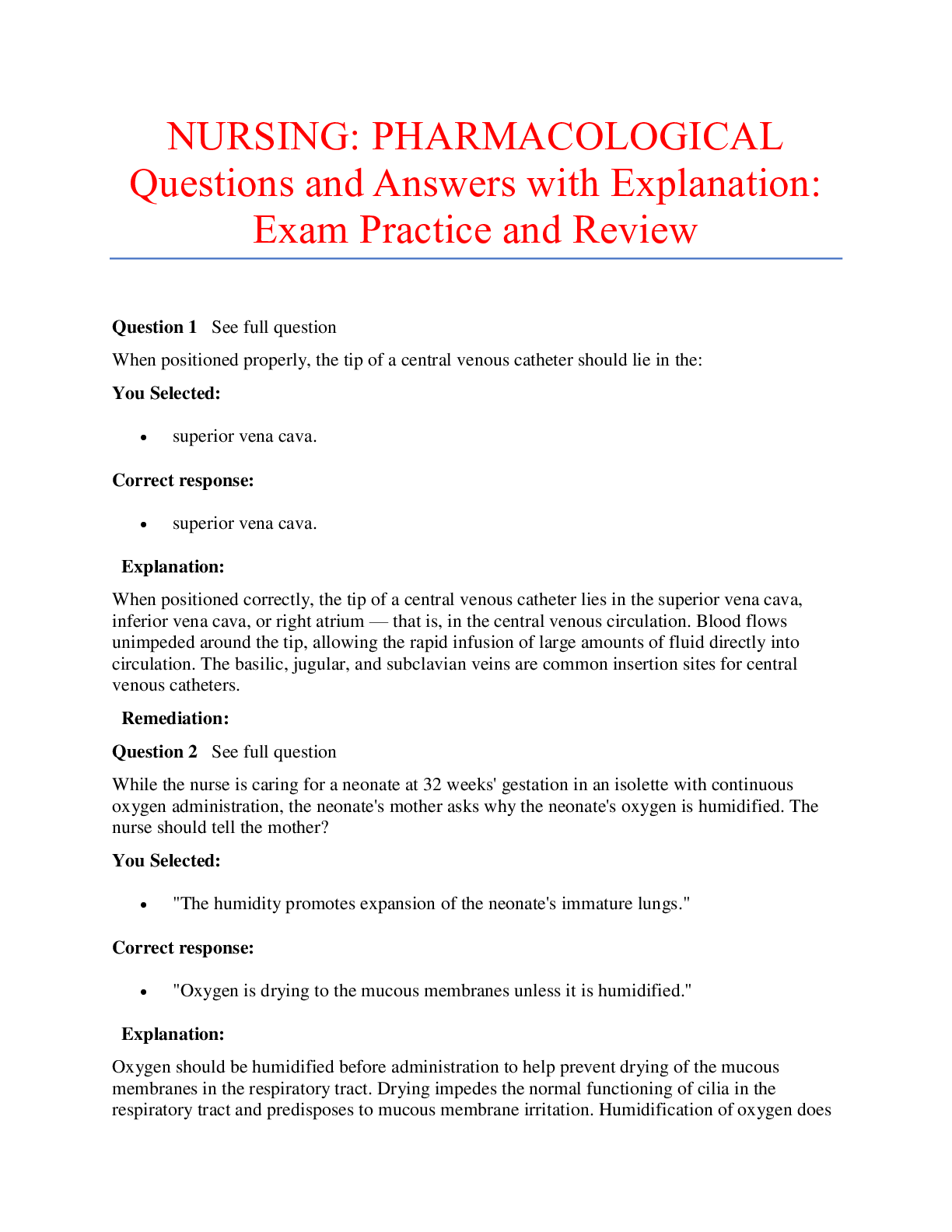
Buy this document to get the full access instantly
Instant Download Access after purchase
Add to cartInstant download
We Accept:

Reviews( 0 )
$9.00
Document information
Connected school, study & course
About the document
Uploaded On
Aug 03, 2020
Number of pages
75
Written in
Additional information
This document has been written for:
Uploaded
Aug 03, 2020
Downloads
0
Views
71

